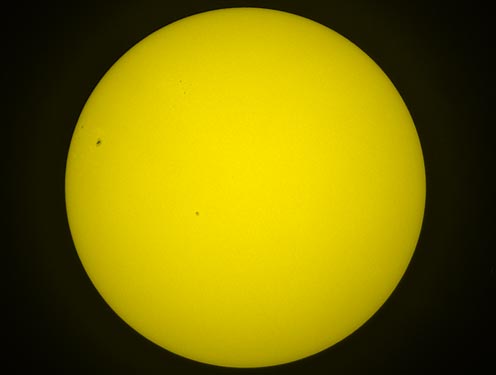|
| |
|
|
 |
|
The others pictures of "Sun" |
|
|
|
|
|
| 1 | 2 | 3 | 4 | 5 | 6 | 7 | 8 | |
|
|
|
|
 |
|
Faculae and sunspots |
|
|
|
|
|

|
|
|
|
|
|
|
|
|
|
|
|
|
|
|
|
 |
|
A few years after the two 2000 and 2002 solar activity maximums, the Sun is rather quiet. Nevertheless some big snspots appear along with very active areas.
In this picture taken with a digital camera photographing the Sun through an eyepiece, the 4 small sunspots drawing a trianglum on the upper left of the Sun, are the rest of the huge sunspot group 720 triggering spectacular auroras. Meanwhile, the sunspot 733 has appeared, but it is much less active than 720 was. Some faint faculae (bright and hotter area on the Sun's surface) are visible on the left of the sunspot 720.
Note: To prevent chromatism troubles due to my cheap refractor, I've stacked 6 photos under Registax in black and white. Then, I colored digitally in yellow the final picture.
|
|
|
|
|
|
|
|
|
|
|
|
|
| Instrument |
|
110 mm focal length, composite of 6 pictures |
| Exposure & film |
1/180 s with digital camera Camedia 5060 fixé derrière oculaire 25 mm sur lunette 80/480 |
| Date & place |
February 9, 2005, Quimper |
|
|
|
|
|
 |
|
The others pictures of "Sun" |
|
|
|
|
|
| 1 | 2 | 3 | 4 | 5 | 6 | 7 | 8 | |
|
|
|
|
 |
 |
 |
|
|
A Shower of
Stars in Brittany

Brittany by night
in panorama!
|
|
|
|
 |
 |
 |
|